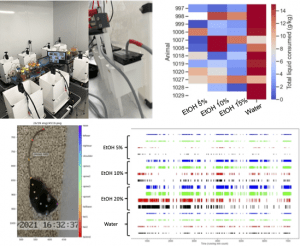Mapping individual differences in the polytrauma clinical triad to substance use risk: a pilot study
 Historically, many rodent models of addiction have been hampered by lack of ethological validity, which may contribute to the dearth of successful translation from pre-clinical animal work to human clinical trials. Single housing of rodents is often required to monitor individual intake levels, which presents a confounding variable and is especially of concern for projects which actively seek to understand the effects of stress and/or trauma on addiction-like outcomes. Likewise, most self-administration procedures offer a choice between the substance under investigation and water (or occasionally sucrose), limiting the translational relevance to humans where multiple substances in varying doses are often available simultaneously. To this end, through advances in RFID technology, we have developed home cages where group housed mice can self-administer up to ten different substances while still maintaining individual intake levels on a second-to-second time scale. Each home cage is equipped with four to ten volumetric drinking monitors (VDM) which enable continuous intake monitoring at 20 ul resolution. Each VDM is located in close proximity to an RFID receiver and each mouse has a RFID transponder implanted subcutaneously behind their shoulder blades. Proximity of the VDM, RFID receiver, and the mouse is ensured with a custom 3D-printed self-administration chamber that is connected to the home cage, this also serves to remove all wires and tubing from the internal cage space. Video is recorded to DVR from above and is only collected when movement in sensed, greatly reducing required disk space. RFID and VDM data streams are combined and analyzed offline using standard Python scientific computing libraries (https://github.com/grace3999/RFID_polysubstance).
Historically, many rodent models of addiction have been hampered by lack of ethological validity, which may contribute to the dearth of successful translation from pre-clinical animal work to human clinical trials. Single housing of rodents is often required to monitor individual intake levels, which presents a confounding variable and is especially of concern for projects which actively seek to understand the effects of stress and/or trauma on addiction-like outcomes. Likewise, most self-administration procedures offer a choice between the substance under investigation and water (or occasionally sucrose), limiting the translational relevance to humans where multiple substances in varying doses are often available simultaneously. To this end, through advances in RFID technology, we have developed home cages where group housed mice can self-administer up to ten different substances while still maintaining individual intake levels on a second-to-second time scale. Each home cage is equipped with four to ten volumetric drinking monitors (VDM) which enable continuous intake monitoring at 20 ul resolution. Each VDM is located in close proximity to an RFID receiver and each mouse has a RFID transponder implanted subcutaneously behind their shoulder blades. Proximity of the VDM, RFID receiver, and the mouse is ensured with a custom 3D-printed self-administration chamber that is connected to the home cage, this also serves to remove all wires and tubing from the internal cage space. Video is recorded to DVR from above and is only collected when movement in sensed, greatly reducing required disk space. RFID and VDM data streams are combined and analyzed offline using standard Python scientific computing libraries (https://github.com/grace3999/RFID_polysubstance).